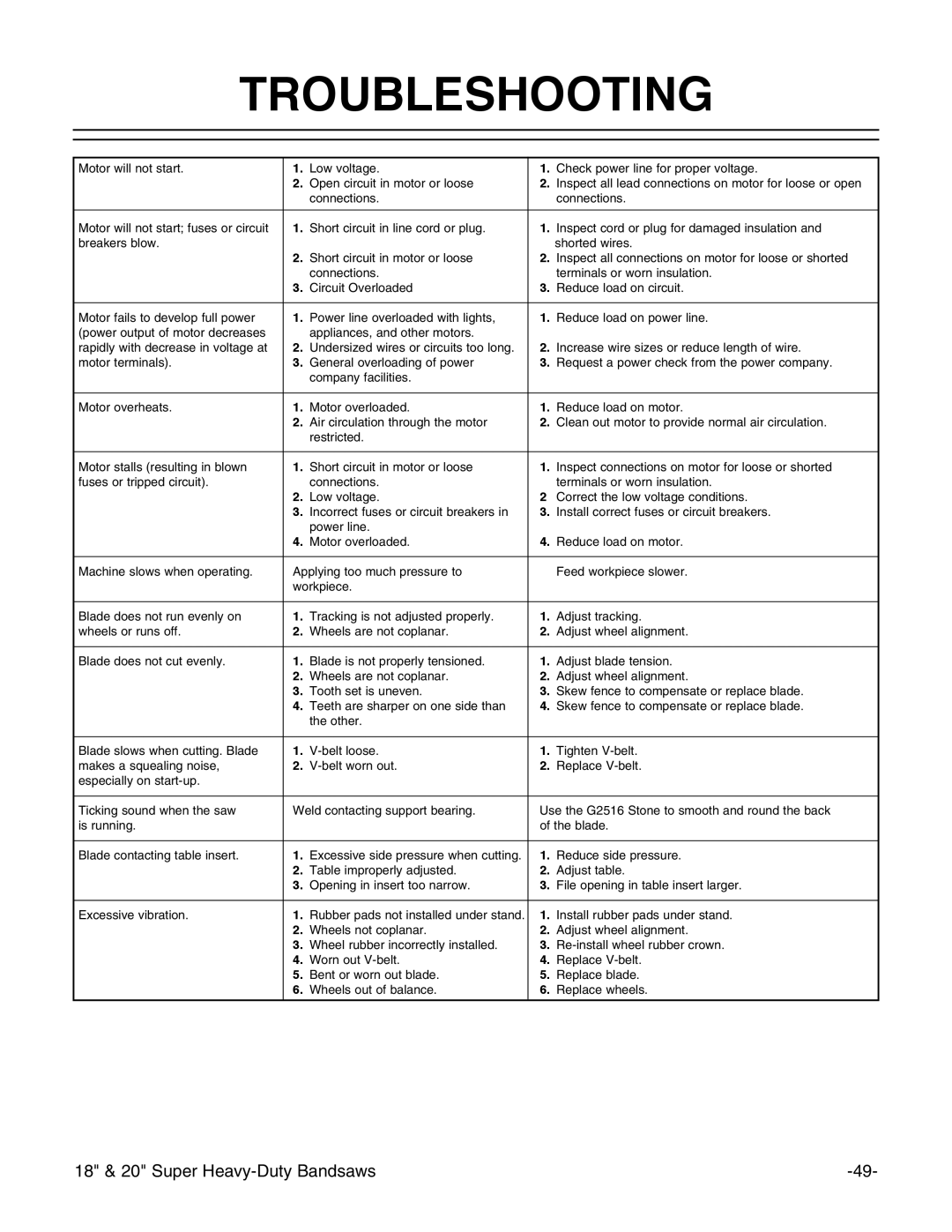TROUBLESHOOTING
Motor will not start. | 1. | Low voltage. | 1. | Check power line for proper voltage. |
| 2. | Open circuit in motor or loose | 2. | Inspect all lead connections on motor for loose or open |
|
| connections. |
| connections. |
|
|
|
|
|
Motor will not start; fuses or circuit | 1. | Short circuit in line cord or plug. | 1. | Inspect cord or plug for damaged insulation and |
breakers blow. | 2. |
| 2. | shorted wires. |
| Short circuit in motor or loose | Inspect all connections on motor for loose or shorted | ||
| 3. | connections. | 3. | terminals or worn insulation. |
| Circuit Overloaded | Reduce load on circuit. | ||
|
|
|
|
|
Motor fails to develop full power | 1. | Power line overloaded with lights, | 1. | Reduce load on power line. |
(power output of motor decreases | 2. | appliances, and other motors. | 2. |
|
rapidly with decrease in voltage at | Undersized wires or circuits too long. | Increase wire sizes or reduce length of wire. | ||
motor terminals). | 3. | General overloading of power | 3. | Request a power check from the power company. |
|
| company facilities. |
|
|
|
|
|
|
|
Motor overheats. | 1. | Motor overloaded. | 1. | Reduce load on motor. |
| 2. | Air circulation through the motor | 2. | Clean out motor to provide normal air circulation. |
|
| restricted. |
|
|
|
|
|
|
|
Motor stalls (resulting in blown | 1. | Short circuit in motor or loose | 1. | Inspect connections on motor for loose or shorted |
fuses or tripped circuit). | 2. | connections. | 2 | terminals or worn insulation. |
| Low voltage. | Correct the low voltage conditions. | ||
| 3. | Incorrect fuses or circuit breakers in | 3. | Install correct fuses or circuit breakers. |
| 4. | power line. | 4. |
|
| Motor overloaded. | Reduce load on motor. | ||
|
|
|
| |
Machine slows when operating. | Applying too much pressure to |
| Feed workpiece slower. | |
| workpiece. |
|
| |
|
|
|
|
|
Blade does not run evenly on | 1. | Tracking is not adjusted properly. | 1. | Adjust tracking. |
wheels or runs off. | 2. | Wheels are not coplanar. | 2. | Adjust wheel alignment. |
|
|
|
|
|
Blade does not cut evenly. | 1. | Blade is not properly tensioned. | 1. | Adjust blade tension. |
| 2. | Wheels are not coplanar. | 2. | Adjust wheel alignment. |
| 3. | Tooth set is uneven. | 3. | Skew fence to compensate or replace blade. |
| 4. | Teeth are sharper on one side than | 4. | Skew fence to compensate or replace blade. |
|
| the other. |
|
|
|
|
|
|
|
Blade slows when cutting. Blade | 1. | 1. | Tighten | |
makes a squealing noise, | 2. | 2. | Replace | |
especially on |
|
|
|
|
|
|
| ||
Ticking sound when the saw | Weld contacting support bearing. | Use the G2516 Stone to smooth and round the back | ||
is running. |
|
| of the blade. | |
|
|
|
|
|
Blade contacting table insert. | 1. | Excessive side pressure when cutting. | 1. | Reduce side pressure. |
| 2. | Table improperly adjusted. | 2. | Adjust table. |
| 3. | Opening in insert too narrow. | 3. | File opening in table insert larger. |
|
|
|
|
|
Excessive vibration. | 1. | Rubber pads not installed under stand. | 1. | Install rubber pads under stand. |
| 2. | Wheels not coplanar. | 2. | Adjust wheel alignment. |
| 3. | Wheel rubber incorrectly installed. | 3. | |
| 4. | Worn out | 4. | Replace |
| 5. | Bent or worn out blade. | 5. | Replace blade. |
| 6. | Wheels out of balance. | 6. | Replace wheels. |
|
|
|
|
|
18" & 20" Super |
